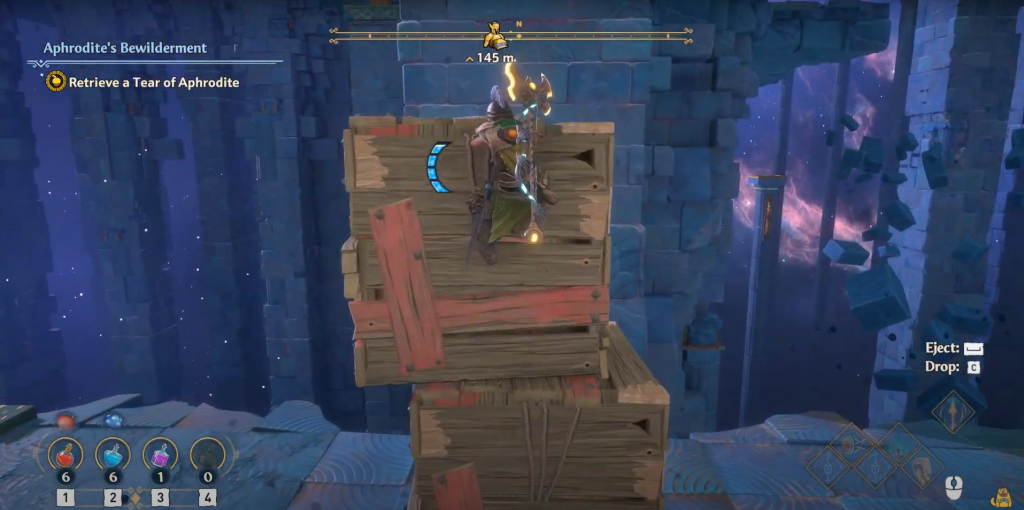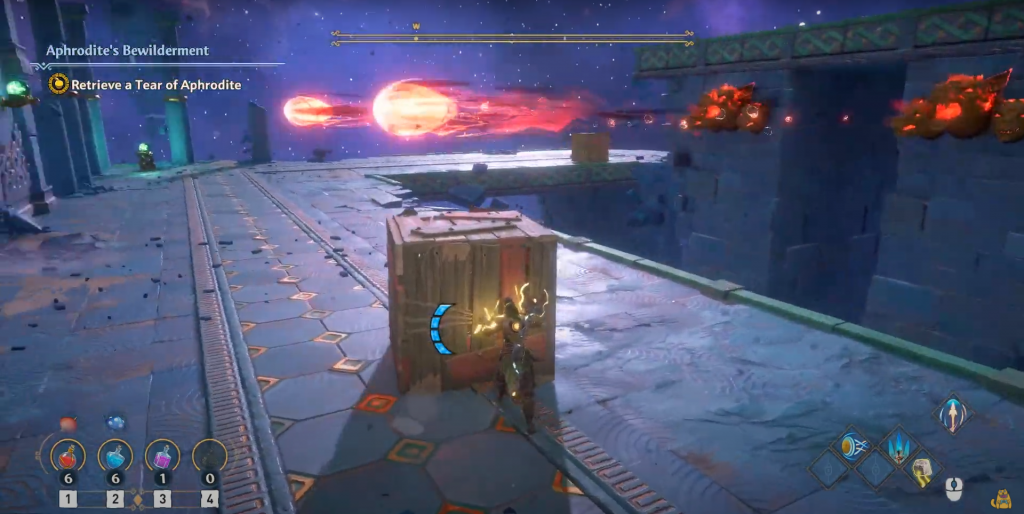
If you read my previous articles or have been hanging around our Discord, you know how much human psychology is of interest to me. One beautiful facet of it is this “game” that players and designers are playing together, for as long as games exist, where both try and trick the other, pushing on their level of control. Designers create playgrounds, full of possibilities, limitations, and challenges, for players to express themselves in it, while players, coming with their experience and expectations, will try and break free from these artificial chains.
Let’s take the enemies we designed for Immortals Fenyx Rising: each of them serves a specific purpose in the player experience and are here to challenge players in a certain way: Captains, spawning minions, will push your sense of target prioritization; Minotaurs are deadly in close-combat if your dodging game isn’t top-notch; Hecatonchires get stunned easily but can be overwhelming… In the end, this was my part as a designer to create inviting and challenging enemies for players to fight against!
And, sure enough, some of these players are playing along with my challenges, trying to study enemies and find their strengths and weaknesses. But, players being players, quite a lot of them are having other plans in mind. Some will just brute force enemies, chugging potions after potions to stay alive. Some others will trick them into falling into pits or throw giant boulders at them. Some will exploit the enemies’ friendly fire and let them kill each other… The inventiveness of players knows no bounds, and this is precisely what is so great about this whole subject!
This back and forth is to me what makes for the best gaming moments, where players feel smart and are rewarded for their wit, get their best “Ahah” moment, and really connect with the designers on an intimate level. I see it as an asynchronous, distant argumentation between players and designers. A friendly face-off.
But there is one flaw in this logic: it assumes players play as they are, independently of the game they play and unaffected by the designers behind it. And this is very far from being the case!
Humans being, as you all know already, are terrifically good at recognizing patterns and creating mental models about them. They will play inside the boundaries you set for them, like an unsaid pact: their perceived freedom, and how they should, or could play, is defined by their knowledge of our medium, their experience with previous games, and what the game teaches them is possible. In our previous enemies example, why don’t players wait for the enemies to go to the toilets to ambush them? Or kidnap their family, blackmail them, or poison their food? Because this isn’t how it works right? That would be ridiculous. And yet nobody taught us that this wasn’t possible!
Our players are tightly guided by preconceptions (most of them being right!), and this leads to some very interesting scenarios and design challenges. A good example is one I stumbled upon while working on Immortals Fenyx Rising.
A story about boxes, and how players can’t think outside of it
So, let’s set the scene first. Immortals Fenyx Rising is a Ubisoft adventure game IP, described by Forbes as “If Zelda and Assassin’s Creed Odyssey had a baby” which will be a good enough description for the purpose of this article.
In this game, the player will fight monsters, solve puzzles, and progress along with a narrative set and heavily inspired by Greek Mythology. Among the multitude of activities to do are the Vaults of Tartaros, which roughly serves the same purpose as the Shrines of Zelda: Breath of the Wild, challenging a particular set of skills around a unique puzzle or game mechanic.

One of these Vaults, “Aphrodite Bewilderment“, is entirely revolving around a single game ingredient: wooden boxes. These boxes are fragile and will break easily, be it by hitting them, throwing them, or dropping them from a high enough height. The player, though, can step on them without breaking them, move them around, pick them up, and stack them.

The entire puzzle is, of course, designed around these specificities: be careful not to break the boxes, move them around, use them as a stepping stone to climb to higher places (eventually having to stack them to create a stairs-like platform), etc.

The main and most convenient way to move these boxes around is to use the telekinesis skill you received early in the game, thanks to Herakles’s bracers: you approach a box, a prompt “[E] Carry” appears, and pressing it will make you carry it above your head and drop it wherever you like:


So far so good! Watching players during playtests didn’t bring any issue and they were engaging well with the puzzle: they would be slowly introduced to more boxes and increasing difficulties moving them around, eventually reaching this particular moment:

This part proved to be the crux of difficulty for most players: two Cerberus’s heads would spit fireballs at a fixed interval, and the player would have to synchronize their movements to ensure no fireball hit the box and destroy it while they cross this corridor.
Quite a lot of players would miss-time the fireballs, get their box destroyed, and go back pick a new one to retry. Since up to 4 boxes will have to be passed this way (for optional rewards purposes), many players would spend an extensive amount of time trying to pass this challenge!
The funny thing? They didn’t have too…

Each box could be simply pushed below the fireballs, which makes this segment a fake challenge: it’s just fluff.

But then why 90% of our players are failing to see it? Because they have been conditioned to do so: Players know they are solving a puzzle, and their experience pushes them to think that there is only one solution to a problem (or at least one RIGHT solution, as designed by the creator of the puzzle). They also strongly believe that no element of a puzzle has been placed randomly and that they all serve a purpose, either to help or prevent solving the puzzle. If these fireballs are here, it’s surely to add difficulty right?
But this isn’t everything, the game played its part too: approaching a box displays a prompt to pick the box (the easiest way to move it around, but far from the only one). Also, the previous segments of the puzzle all required the player to carry boxes this way. Why change what you’ve learned to do?
In the end, players won’t think outside the box unless specifically pushed to do so, and will keep the suspension of disbelief and their beliefs when solving a puzzle. Some games manage to guide players beautifully into having this state of mind, like the famous Portal and its sequel: being part of an experiment and guided narratively to trust at no cost Glados the AI, players are naturally drawn to experiment outside the game’s predefined boundaries (and puzzles often allow for multiple solutions).

When the game, on the other hand, tries to force this behavior in players, without the proper care, it leads to very frustrating or seemingly impossible situations, like some advanced puzzles in Fez or some bosses like the infamous Bed of Chaos in Dark Souls that stomped on the players’ perception of the game’s expectation.
In Immortal Fenyx Rising, though the direct approach will always work, a multitude of other approaches are up to the player to discover. These alternative approaches are rarely used, which could have been prevented by advertising more this way of thinking. These examples include multiple puzzles that could be entirely bypassed by simply breaking through the chest room wall:

Or even how pressure plates work: players would often look for the specially made block to solve the puzzle (and there is always one), but anything else in the world would work too: a random stone, an enemy (tips: cyclopes are great for this purpose!), your horse, yourself even! And yet players will keep running in a field of stones trying to look for the real block.

To conclude, I do believe that both players and developers have a responsibility into breaking these age-old patterns. Players often advocate for more freedom in games, but fail to truly embrace it when given to them. Challenge games, try to see beyond what the game seems to want from you, express yourself in the gameplay!

To developers and designers: do not be afraid of players breaking the game. A player managing to bypass an entire puzzle with their skills, wit, and deep understanding of the game will leave them with a sense of achievement greatly superior to what they would have achieved following strict game’s directives. Try as much as you can to open your designs and let the player know that your games are real playgrounds for them to have fun in them! Inspire yourself from games that truly embraced this philosophy, games like Super Mario Odyssey or the Hitman series. You will create better, more engaging games.

I’ll leave you with a full walkthrough of the Vault I used as an example in this article, done by one of the few players that actually realized they could move the boxes after carrying the first one through!

Do you want to get regular quality articles on Game Design and join an awesome community of devs and designers on our private Discord to discuss design, learn, and review each other’s games? Then consider supporting GDKeys.

I haven’t played Fenyx Rising so my comment might not apply. In a lot of games pushing boxes can be boring and kind of slow. Maybe the reason a lot more people carried the box instead of pushing it is because pushing takes more time. I know I’d rather take the risk and carry the box with the potential to fail rather than push the box and take my time.